Ed. note: Today marks 30 years since I started this food/restaurant/critic gig with my first “Food For Thought” commentary on KNPR – Nevada Public Radio. From radio to print to TV to books to the internet, it’s been quite a ride, and feast! In recognition thereof, the above pic charts some of my looks (with some of my favorite chefs) over the years, and here’s a new article celebrating…
WHAT’S NEW IN VEGAS – 2025
Reports of Las Vegas’s demise have been greatly exaggerated. True, tourism is down (around 10%), and prices are up (more on this below), but the conventions have returned, and on most weekends, reservations in the better restaurants are harder to find than single-deck blackjack. Chinatown continues to boom, and the Arts District (downtown) has so many bars, brewpubs and watering holes that you’ll never be thirsty for more than half a block. On the Strip, a famous face has relocated himself into sparkling new digs, upscale Asian shows no signs of abating, upscale Indian is the new rage, and the best restaurant in town just celebrated its twentieth anniversary.
JOĒL ROBUCHON TURNS 20

When Joël Robuchon first planted his flag on American soil in 2005, it was not in New York, California or Chicago, but with two restaurants — Joël Robuchon and L’Atelier de Joël Robuchon — side-by-side at the MGM Grand in Las Vegas. Their arrival was heralded by Ruth Reichl at Gourmet magazine as a seminal moment in American gastronomy. Robuchon had been fêted ten years earlier as the “Chef of the Century” by the Gault-Millau restaurant guide, and his sushi bar inspired L’Atelier, and more formal namesake room were giant leaps forward for French food both haute and bourgeois, in Vegas and elsewhere. In 2011, original chef Claude Le Tohic won a James Beard award for Best Chef Southwest, and in the ensuing years, both restaurants have remained true to the master’s reputation for maximum flavor extracted with precision and presented with elegant simplicity.
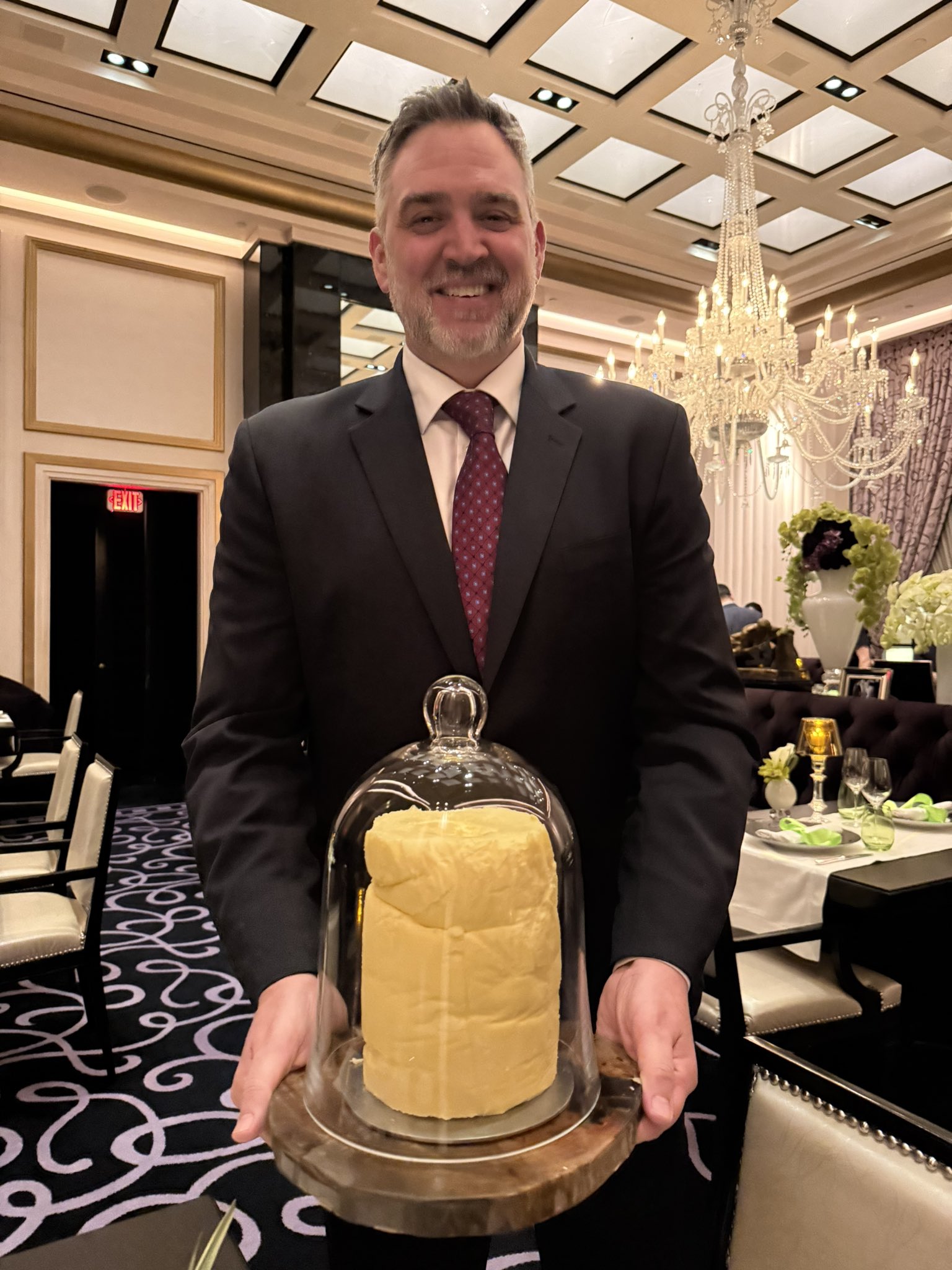
We’ve sung this restaurant’s praises so often we almost feel like a broken record, but so many things about it are sui generis. A formidable mignardise trolley still beckons as you enter the dining room, foretelling your willpower’s inevitable demise — diet death by a thousand cakes. The bread cart alone (presented with 16 varieties, all baked in house), has to be the most impressive in America. The Bordier butter precedes it (above), wheeled to your table under a glass dome lovingly encasing a cylinder of Brittany churned cream the size of an artillery shell. Whatever amuse bouche appears (such as lemon gelée topped with anise cream) will have you scratching your head as to how much flavor punch can be compressed into such small bites.
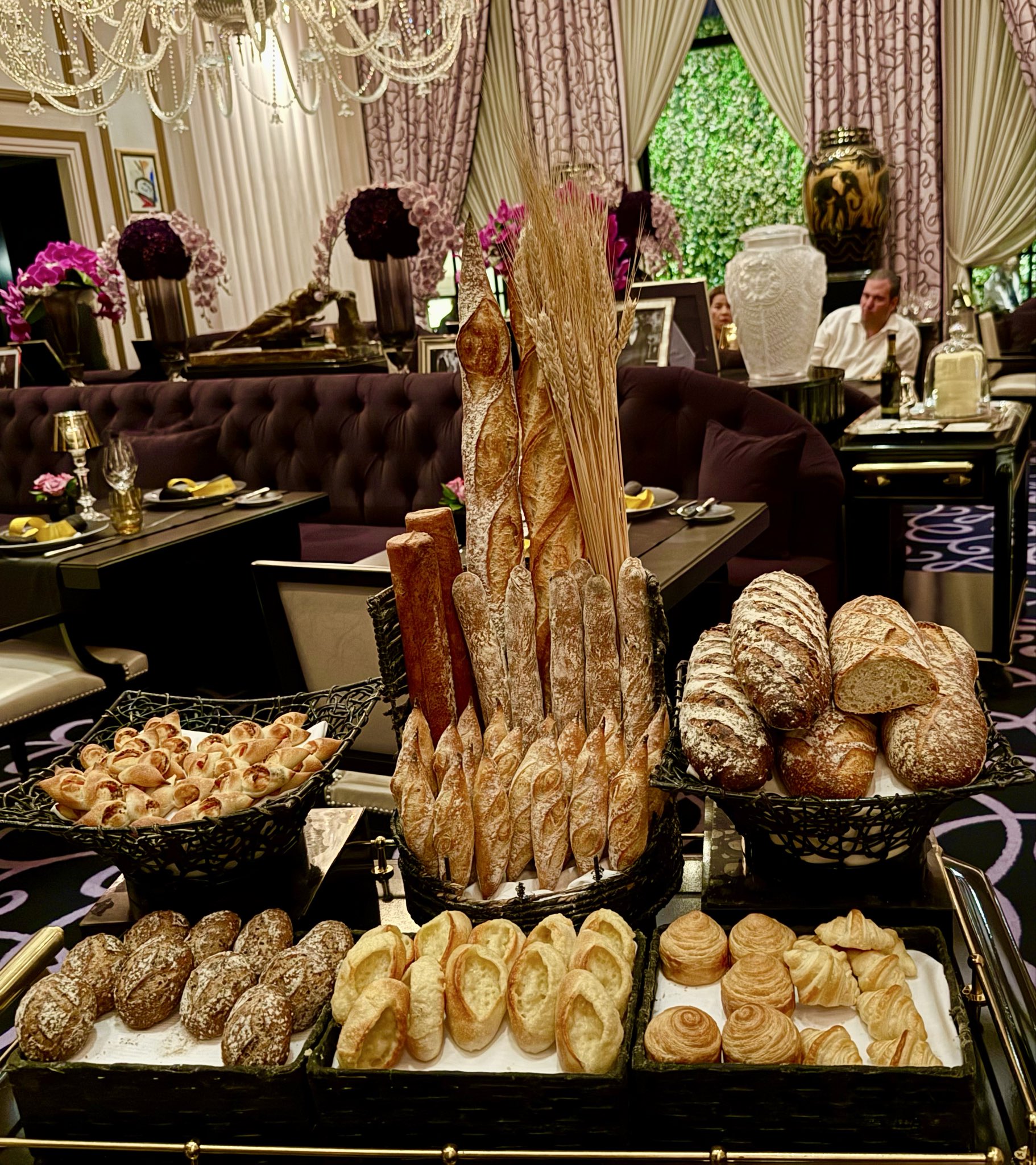
Robuchon (who died in 2018) drilled his troops well, and you can taste his attention to detail on every plate. In celebration of the anniversary, we indulged in a re-creation of one of the original tasting menus ($275 then, $525 now, with less expensive a la carte options available). Executive Chef Elezar Villanueva (a James Beard finalist this year) still performs minor miracles with a humble ingredients: cream of lettuce soup, tuna tartare with bell pepper confit, and a single frog leg wrapped in kataifi (shredded filo dough), punctuated with garlic and small chanterelles.
This is cooking at its most elevated, but without affectation. No slight of hand is invoked, nor guess work required. In keeping with Escoffier’s philosophy, things taste like themselves, only more so. So it is with a 48-hour (sous vide poached) leg of baby lamb, so tender and gently infused with Moroccan spice you’ll question ever enjoying lamb any other way. Or his Brittany lobster in a small pool of seafood bouillon — the briny concentrated flavor of the homard moderated by the slightly sweet broth. The usual haute cuisine signifiers — caviar, truffles and foie gras — are in use but judiciously so. Nothing overwhelms; everything has its place. The point being to make every bite a revelation, on the palate, not on the internet.

The deep purple and cream decor, replete with the obligatory flowers, soothing drapery and massive chandelier, has held up well, invoking late Twentieth Century Michelin-approved plushness without stuffiness. Whatever haughtiness you might expect from such a formal dining room is quickly dispelled by a staff that puts everyone at ease. Many of them are multi-lingual, and all seem to have a twinkle in their eye as they guide you through some of the best cooking on the planet.
DOWNTOWN’S FRENCH REVOLUTION
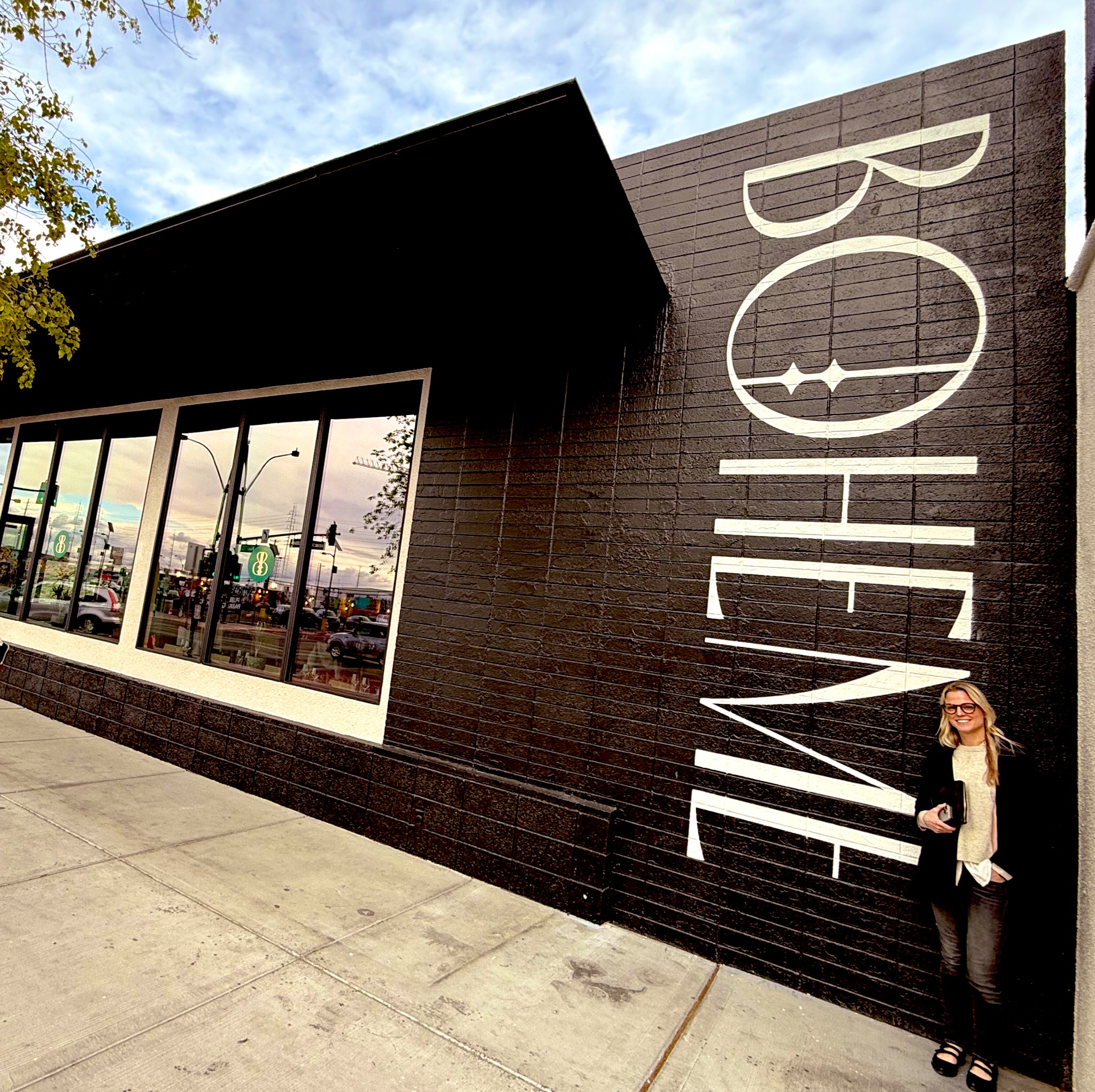
French food in Las Vegas may have gone through a resurgence in the early aughts with the likes of Robuchon, Guy Savoy, Pierre Gagnaire coming to the big hotels, but in the neighborhoods, the pickings have always been slimmer than a ficelle. Whether James Trees’ Bar Boheme signals a bistronomy renaissance remains to be seen, but its opening in mid-year gave lovers of Gallic cuisine a reason to rejoice.
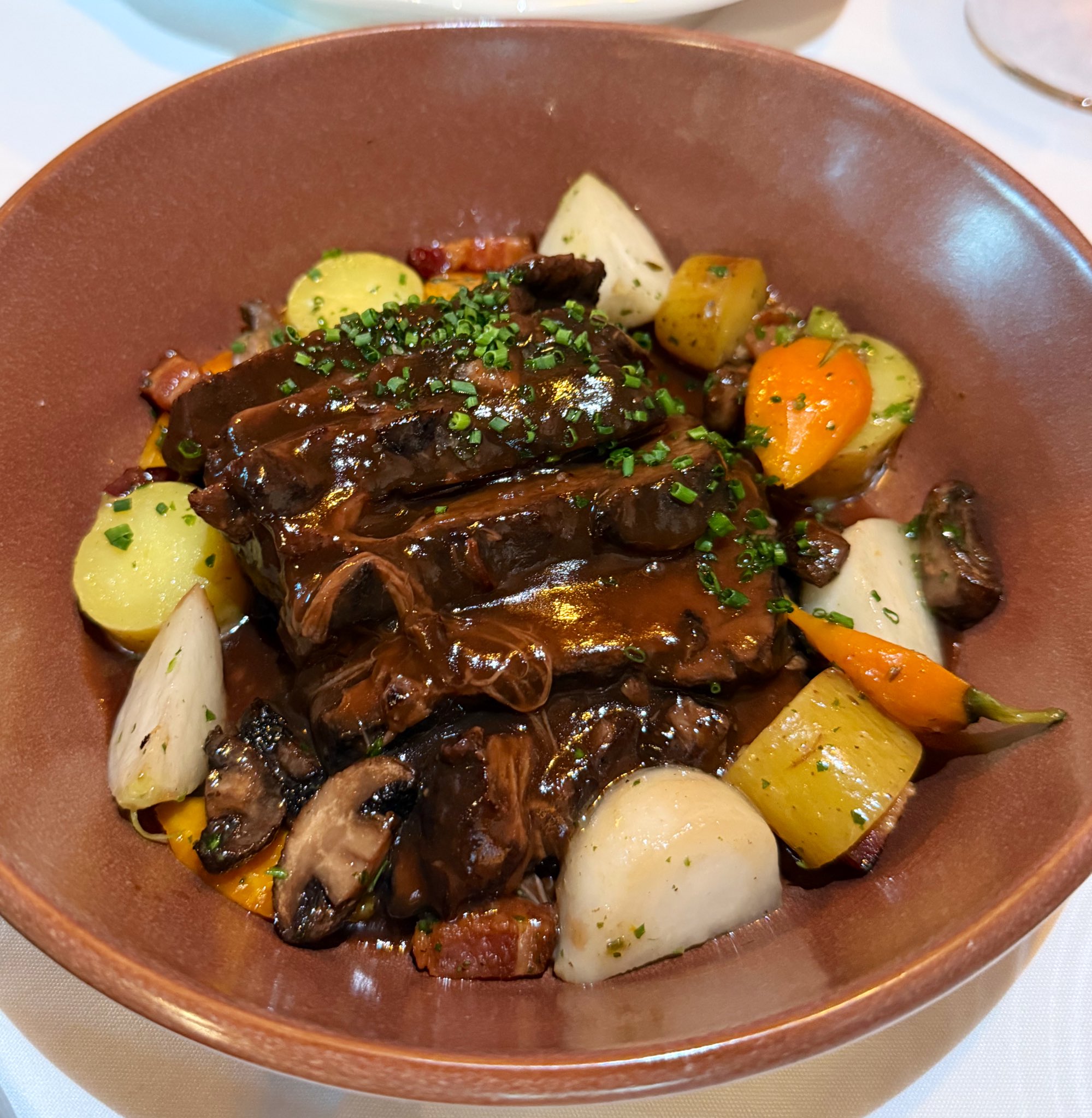
Finally, a full-fledged, unapologetic frog pond, smack in the middle of the Arts District, dishing up toothsome takes on boeuf Bourguignon (above), sole Veronique, escargot and soupe a l’oignon. Slide into a corner booth, and dive into the all-French wine list with your tarte flambee, steak frites or crispy-skin poulet roti, and you can almost convince yourself you’re on the Rive Gauche.
Even though Trees made his name with the wildly popular and very Italian Esther’s Kitchen (just down the street), he was classically-trained in the French catechism (at the CIA, then stints with Eric Ripert, Heston Blumenthal, and Michael Mina, among others), and will tell you his first love was cuisine classique. Like the French, he takes his culinary cliches very seriously. His baguette is baked in-house, and his chicken liver paté, frisée lardon salad, and that onion soup are an exemplars of the form. Burgundy snails get their own puff pastry jackets, and the duck fat fries are in a league of their own.
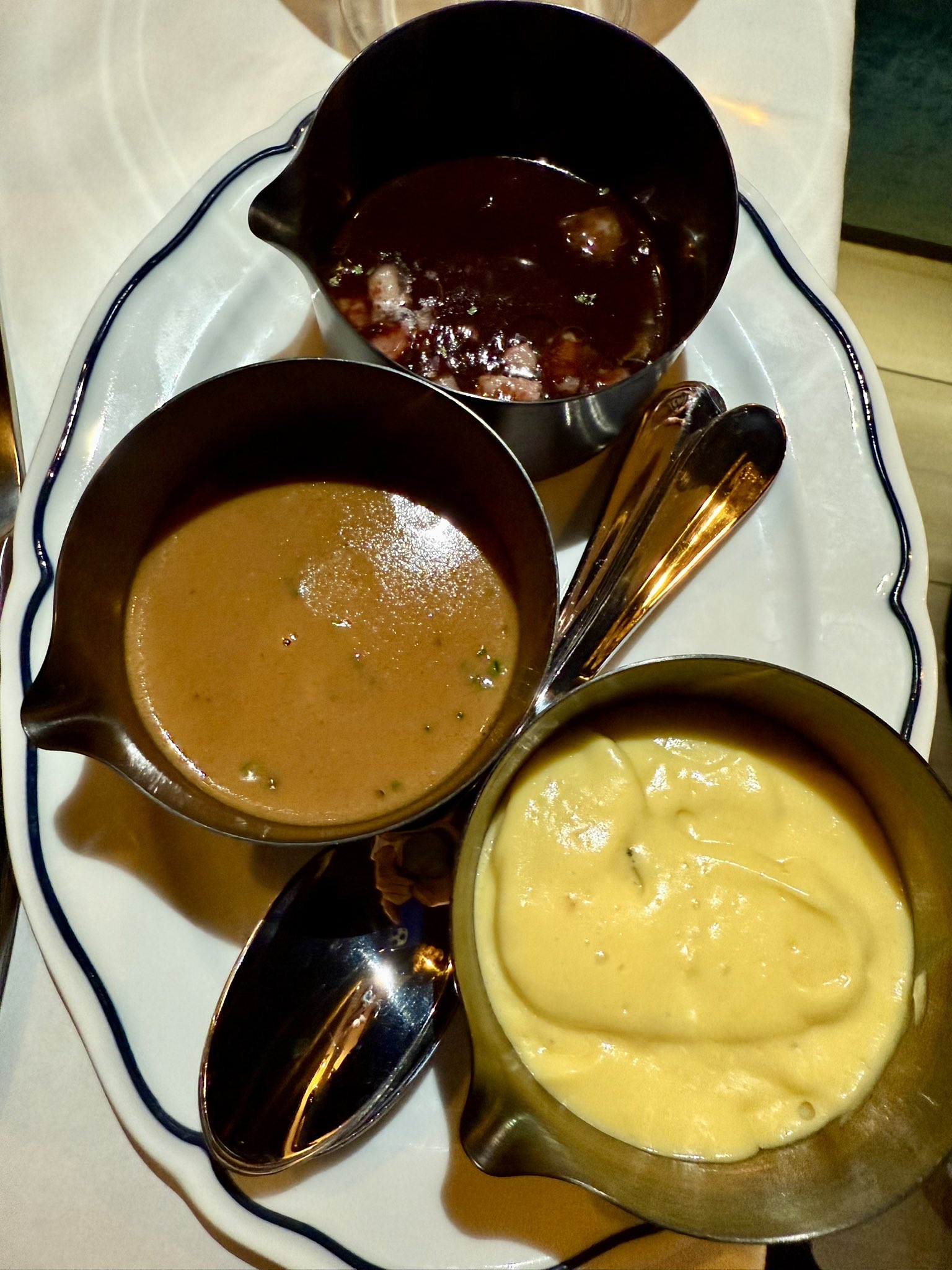
Trees also sources good beef and knows how to sauce it — with flawless renditions of au poivre, Bordelaise, and Béarnaise accenting the bavette, filet and rib eye. Further good news comes from the pricing. Those cuts cost substantially less than they do two miles to the south. A 32 ounce, dry-aged entrecôte (boneless rib eye) here runs $155. At some of our more famous steakhouses, you’ll pay twice that. With a sophisticated cocktail program and top notch management, Bar Boheme has made a statement, and is looking to change the face of Main Street into something besides a good place to do a pub crawl.
SO. MANY. STEAKHOUSES.
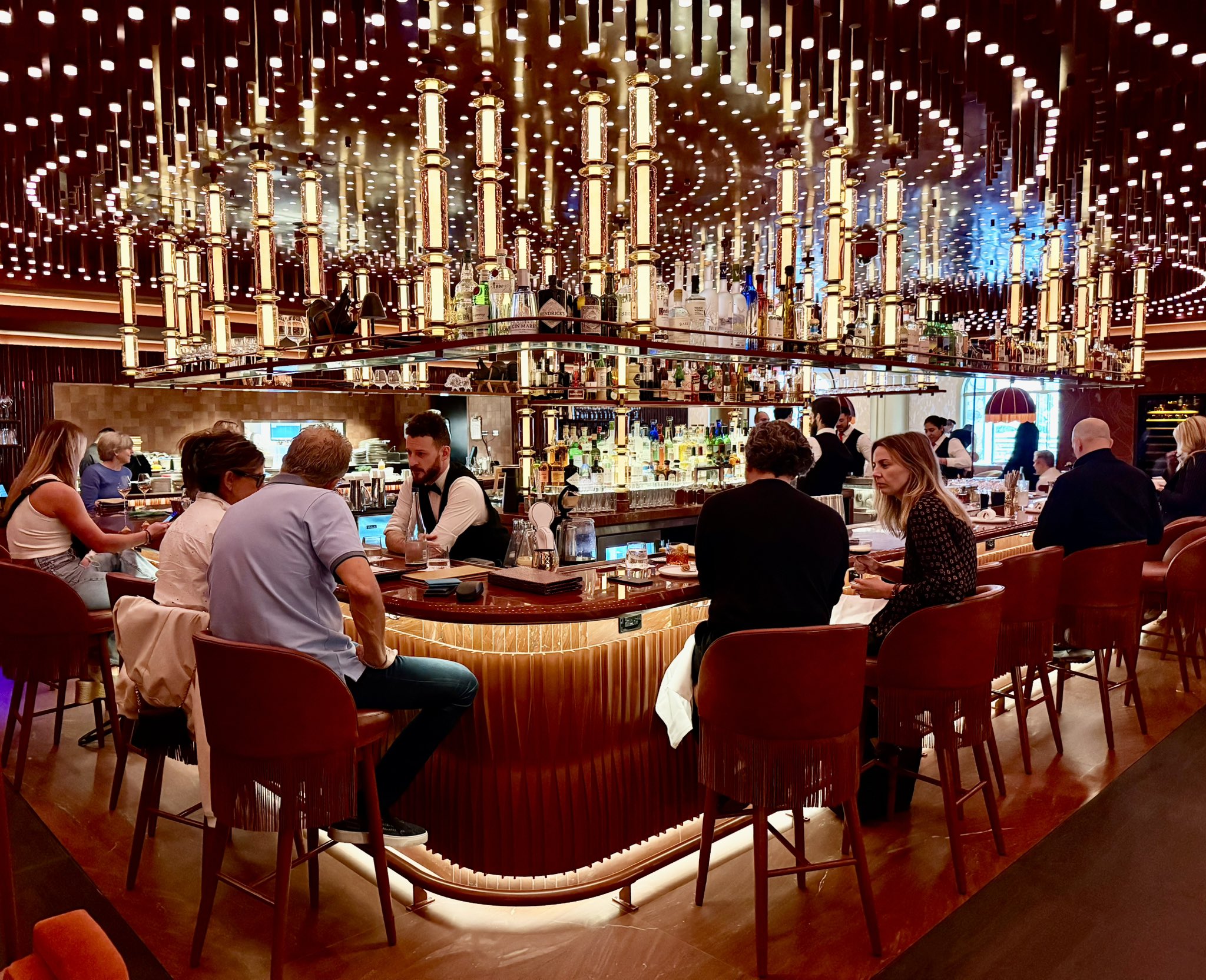
Speaking of beef…yours truly has maintained for thirty years that every restaurant in Vegas would be a steakhouse if it could be, and The Venetian/Palazzo seems hellbent on proving me right. In less than a month, three new ones (Bazaar Meat by José Andrés, COTE, and Boa) all opened within a two minute walk from each other, bringing the total number of carnivore emporiums inside the complex to six. Bazaar Meat brings with it the most intrigue since for the past ten years, it’s been a bastion of prime stuck in a less than choice hotel (Sahara). With flashy new digs on the ground floor of the Palazzo, it boasts a similar menu, a huge front and center bar, two large dining rooms and an open kitchen in front of which you can examine the premium/pricey cuts ready to be be Josper-grilled to your cholesterol-enhancing satisfaction.
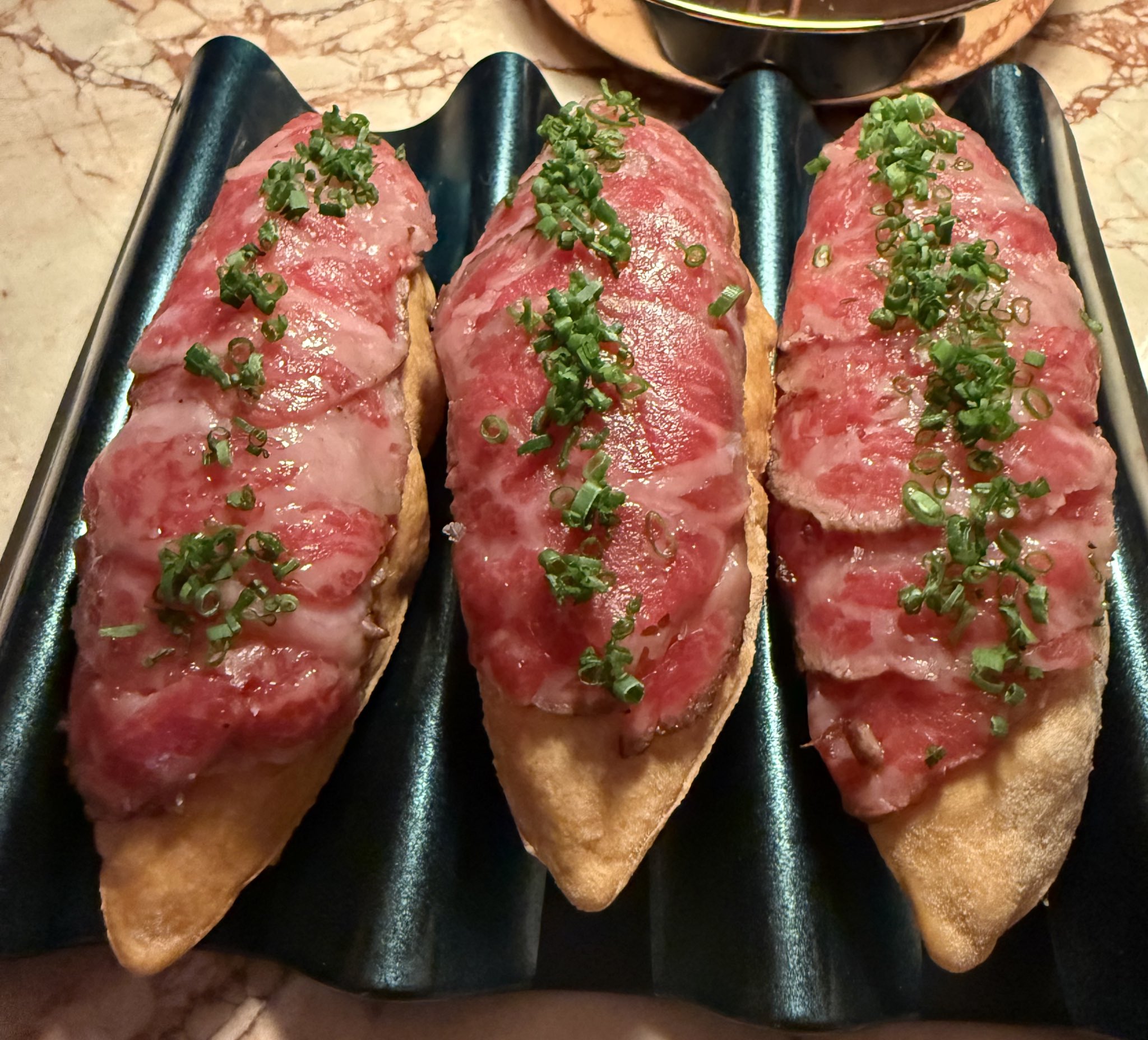
They tell me menu changes will be made, but from where we sat, the pan con tomate, jamon Iberico de Bellota de pata negra, steak tartare, tomato tartare, air bread “Philly cheesesteak” sandwiches, and vaca vieja (8-10 year old Black Angus, aged on the hoof) steaks, are as fine as ever. You can appreciate Bazaar Meat as a steakhouse, a Spanish restaurant, or a wine and tapas bodega (with corresponding price points), and be assured of a fine time. Our last meal here was comprised of only “little snacks” and “little sandwiches” all of which are priced well under twenty bucks. Be advised though, those prime cuts get way north of a hundred bucks in a hurry. Go with a group and split the cost to get the most bang for your buck.
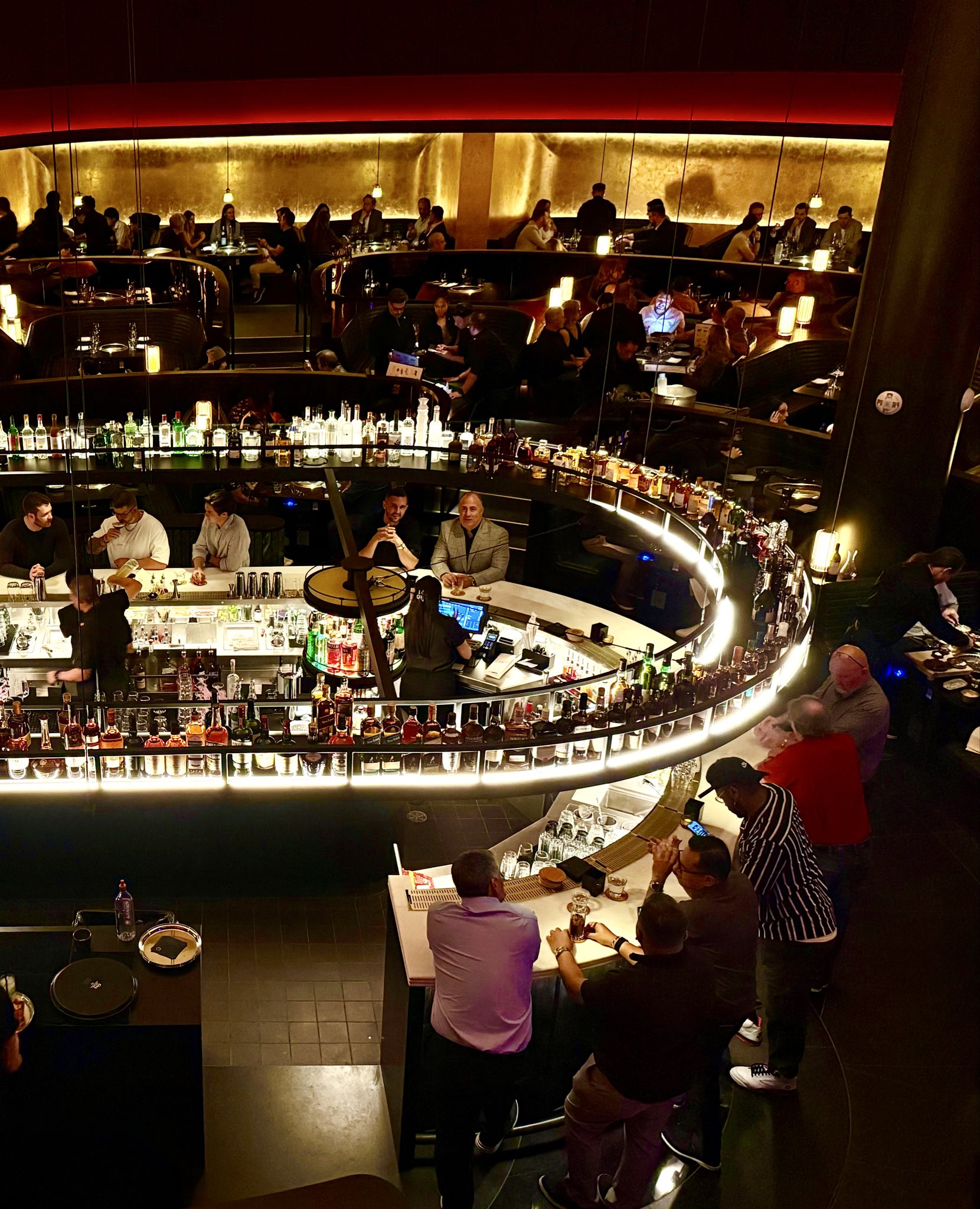
COTE is a steakhouse of a different slice. Korean barbecue to be precise, where the meat is pre-cut and cooked in front of you. Right next door to Delmonico and only a chip shot from CUT, it aims to capture the “We’re looking for a vibe-y experience with out steak” crowd — the same folks who consider Papi Steak (with sparklers in its steaks) and STK (with its dj curated incessant din) the ne plus ultra of a meal on the town.
But COTE throws these party-goers a curveball by actually being food-focused, as opposed to a glorified nightclub with obscenely-priced meat. Its vibe was honed by Simon Kim in New York City, where, in 2017, he captured the zeitgeist of the time by combining a dark, moody vibe with superior cuts of Korean barbecue and a world-class wine list. Faster than you can say bulgogi, the world beat a path to his door. As concepts go, this one is born to travel, and this fourth incarnation (after NYC, Singapore and Miami) is sure to hit with both gastronauts and food fashionistas.
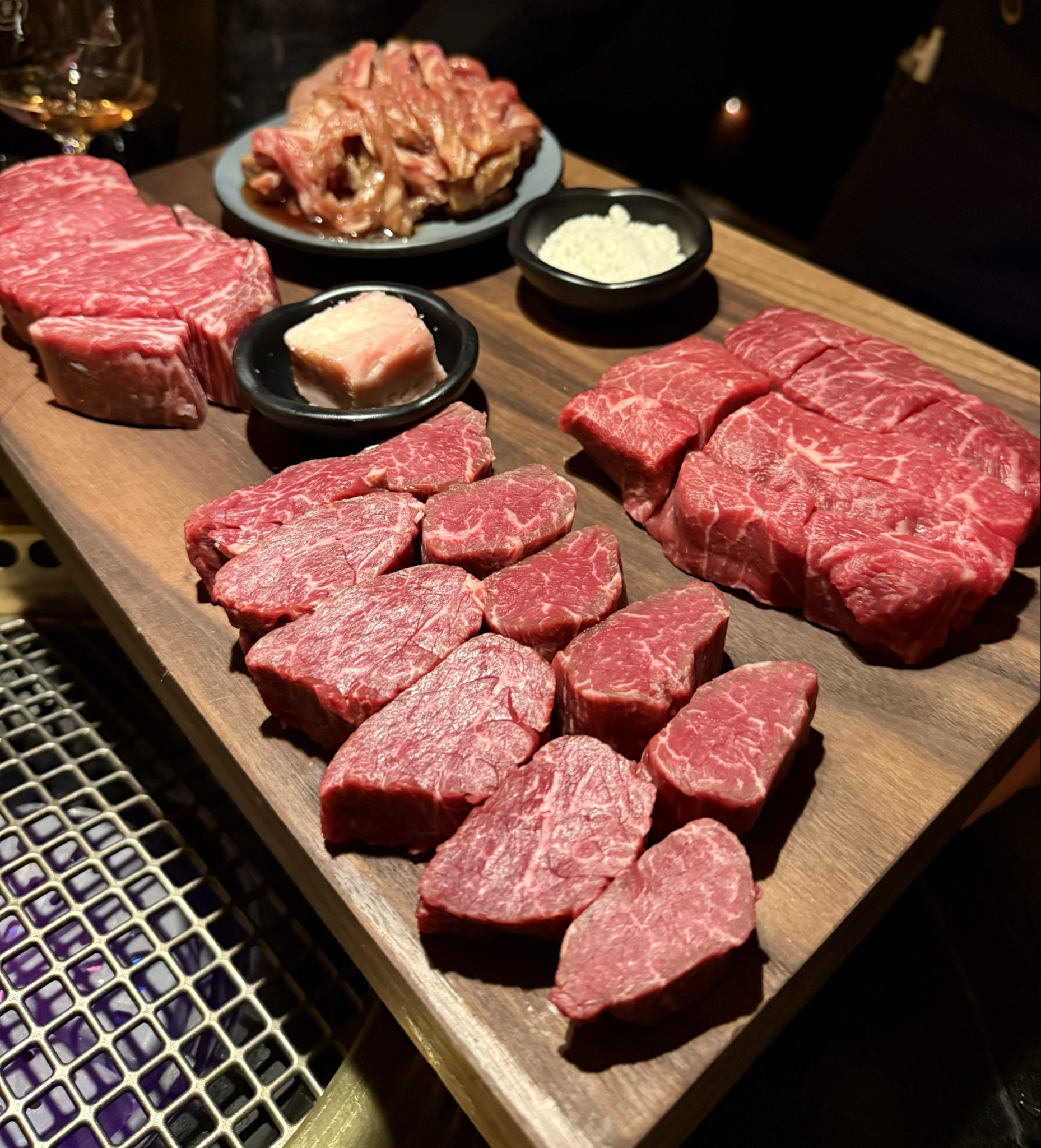
From a person-of-a-certain-age perspective, the lighting isn’t that dark, the music not intrusive, and the booths as comfortable as booths can be. They cook the meat for you here, over smokeless grills, and the choices are geared to steer you to one of two tastings: and $88.88/pp “Butcher’s Feast” or the $225/pp “Steak Omakase”. Our group of famished flesh eaters found the smaller menu more than enough, with its four cuts of various fattiness more than enough to overwhelm our livers.
The limited banchan, still earned our Korean companions’ seal of approval, as did the shochu offerings. Of the various sides and apps we tried, some — Korean “bacon”, Caesar salad — were fine but unmemorable, and the kimchi wagyu “paella” felt like nothing more than a misnamed plop of spiced rice. The wine list is truly impressive, with prices to match, natch.
PLANTING A SEED
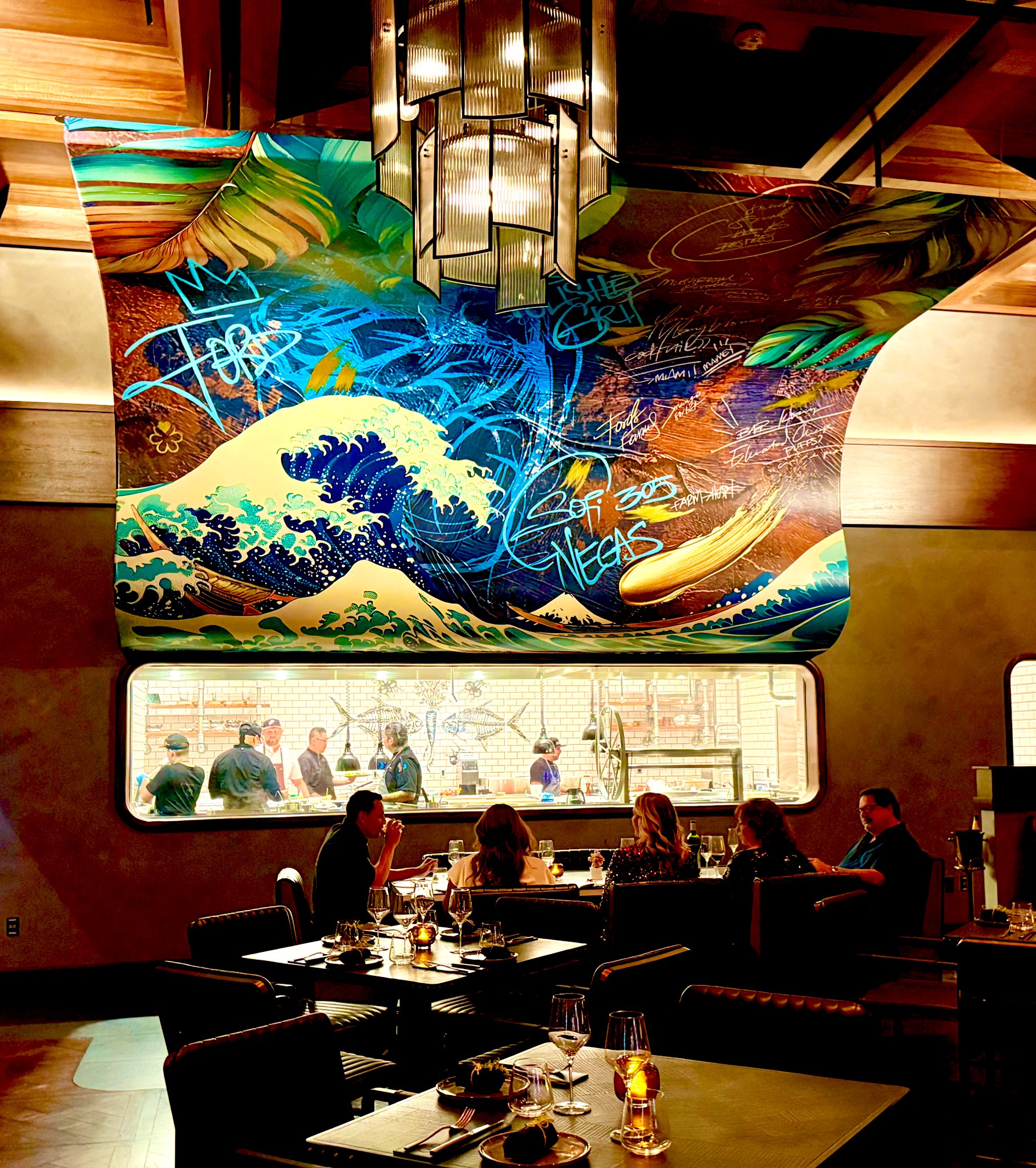
The name — Stubborn Seed — is, depending on your generosity of spirit, either confusing or really stupid, since it tells you nothing about what to expect. Perhaps it makes more sense in Miami Beach, where Chef Jeremy Ford made it big, won a TV cooking competition (Top Chef season 13), and then got recruited to bring his concept to Resorts World in hopes of enhancing his brand and the foodie the cred of the hotel. Confused you may be as you walk to your seat, but several bites in, seated in full view of the large brightly-lit window framing the kitchen, you will realize you are in for something special — a different sort of restaurant, featuring high-wire, aggressive, veggie-focused (but not strictly vegetarian) cooking unlike any in town.

Ford’s claim to fame is the intricate mixing of food metaphors, playing with odd combinations (and lots of leafy accents) that always seem to work. Thus will you find carrots charred with jerk seasonings and spiced yogurt, and a whole cauliflower roasted with a cashew puree, then garnished with seemingly every herb in the garden(above). House-cured olives come with a festoon of fried jamon Iberico, Yellowtail crudo is cured by sake and citrus, and small pasta pyramids of harissa lamb fagottelli gets gussied up with a ginger tomato emulsion, sweet hot peppers, pinenut dukkah and crispy leeks. This is high wire cooking without a net and Ford and his crew clearly have the chops for it.

His proteins don’t miss many beats either: a foie gras/truffle tart (above) reminds you of a glorified PB&J; branzino in nutty brown butter and hazelnuts, is a worthy upgrade of an often boring fish, and a slow-cooked smoked beef rib (priced-to-sell at $85) are as good as anything you’ll find in most steakhouses. None of this is cheap (the rib runs $80), but compared to most Strip restaurants these days, $145 for a set tasting menu feels like a bargain. You can also downsize by going a la carte, which is how to get the crispy, charred double-smash burger with “crave” sauce ($28), which should not be missed. Desserts — peanut butter/fudge brownie candy bar, olive oil cake citrus Pavlova with caramelized pistachios, warm snickerdoodle cookie with toasted barley ice cream — pull out all the stops and hit all their marks, impressing even this jaded palate.
Stubborn Seed is definitely the most compelling Strip restaurant to open this year, full of interesting ideas and flavor combinations which delightfully challenge your taste buds without intimidating them. We are rooting for it to find an audience.
SUBCONTINENT SUPERSTAR
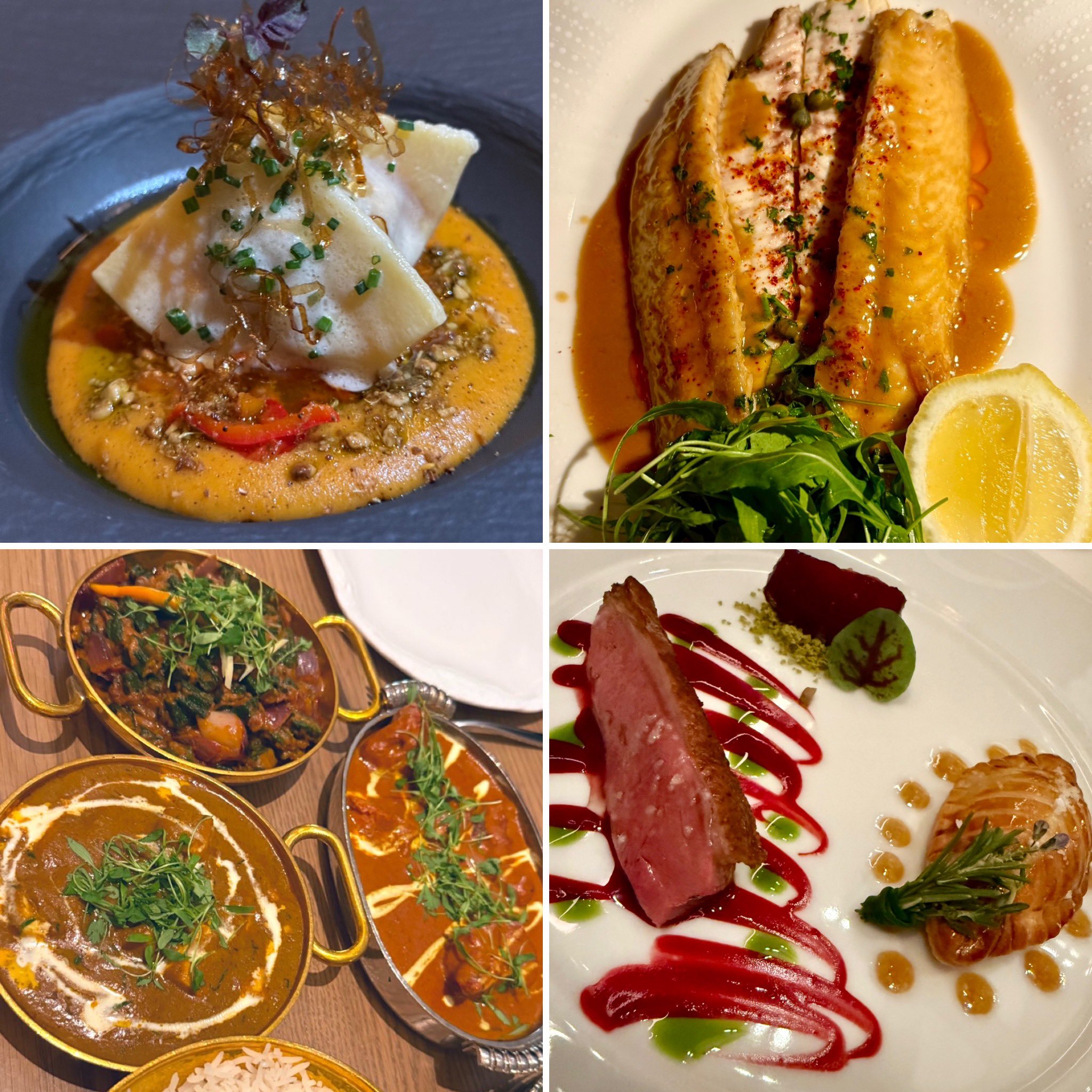
Calvin Trillin once wrote that the average Italian restaurant gets more customers in a night than a good Indian joint sees in a month. Indian food – one of the world’s great cuisines – has been so underrepresented in America as to be almost invisible. Urban areas have their generic tandoori parlors and AYCE buffets, but for decades that was about it. But the tide may be turning. The elegant, sophisticated Indian cuisine of the sub-continent might be having a moment, here and elsewhere, and in Las Vegas, Tamba is leading the way.

Located in the Town Square shopping mall south of the Strip, Tamba has as much in common with your standard, cookie cutter curry shop as a Bentley does with a Dodge Dart. This is apparent from the moment you step inside. Instead of cliched decor and nonstop Bollywood videos, what confronts you is a subtle, subdued restaurant of overstuffed chairs, refined tableware and an eye-popping bar that would be right at home in the Bellagio.
Once you are seated, Chef Anand Singh flies you around the sub-continent (and across the Pacific rim), dabbling in everything from upscale tuna sushi with smoked sea salt to artichoke sashimi to a Hakka (Chinese) noodle stir-fry. Spicings are precise, presentations polished, and the multi-layered flavorings a revelation. (A one-curry-fits-all stop this is not.) You can go traditional with an intriguing hand-folded Samosa Chaat (stuffed with curried chickpeas, masala-spiked potatoes and tangy pomegranates), dry-spiced lamb chops, or soothing butter chicken, or test the kitchen’s more modern chops with its takes on grilled Afghani saffron paneer, banana leaf-wrapped sea bass, or Josper-grilled octopus with purple cauliflower. Either way you will be wondering where all these spices have been hiding. You can also be assured that whatever hits your table will be like nothing Vegas has ever tasted.
Upscale Indian restaurants like this have been in England for a century, and updated takes on this food have been the rage in London for twenty years. Vegas may be late to the party, but with Tamba and, later this year, the arrival of Gymkanha to the Aria, Las Vegas may be maturing into a deeper appreciation of broad range of ingredients, techniques, and flavor packed into these dishes. Whatever magic spice Singh and manager Olivier Morowati have concocted seems to be working. (Grinding and mixing all of their masalas and curries in house is part of the secret.) Whatever the alchemy, local foodies have taken to this place like naan to a tandoor, portending, perhaps, the long overdue celebration of one of the world’s most fascinating cuisines.

